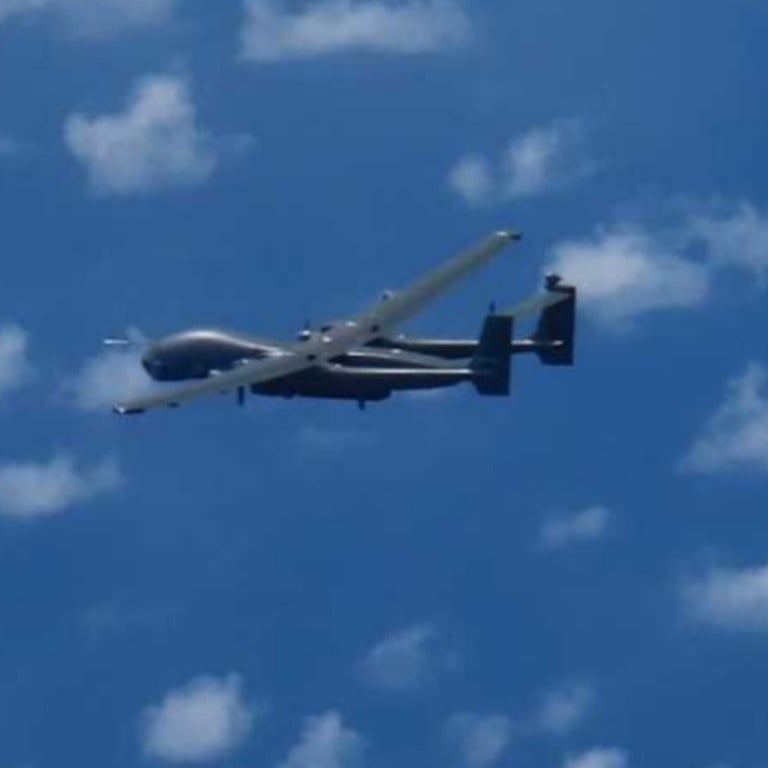
Explainer | How would Taiwan’s planned US$143 million defence system ward off drones from mainland China?
- The system developed by a major military research and development body aims to detect and jam small UAVs to protect essential facilities and the coast
- Many countries have focused on measures to tackle drones as they play a growing role in modern conflict
Taiwanese forces shot down drone over tiny island near Chinese mainland
What is it and will it work?
The remote-controlled unmanned aerial vehicle (UAV) defence system is being developed by the National Chung-Shan Institute of Science and Technology (NCSIST), the island’s major military research and development body, whose other products include Sky Bow air defence missiles and Hsiung Feng anti-ship missiles.
Meanwhile, the new weapons for which the Biden administration seeks congressional approval include 60 AGM-84L Harpoon Block II anti-ship missiles for US$355 million, 100 AIM-9X Block II Sidewinder tactical air-to-air missiles for F-16s for US$85.6 million, and US$655.4 million for a surveillance radar contract extension.
Detection and jamming
The anti-drone system has been designed primarily to detect and jam small UAVs.
An NCSIST introduction video highlights the drone’s search radar that can detect an encroaching UAV and identify it using a camera and frequency detection. When it is clear the intruder is an enemy drone, an electronic jamming system will disrupt its controls before a retrieval drone captures the invading UAV with a net.
This system could be used for “security defence, airport protection, coastal security protection and monitoring, border security protection, important facilities and incident protection, terrorist attack protection”, the NCSIST website said.
Taiwan’s defence ministry last week announced it had completed plans to establish the remote defence system “to deal with the incursion of civilian drones”, according to local media.
The ministry plans to deploy the system over the next four years at all bases, ports, and airports as well as on 45 offshore islands and isolated camps, high mountain platforms, missile positions and other important agile camps. The ministry said any drones invading those areas would be sought, found and disrupted.
Risk of a clash rises after Taiwan fires at mainland drone, analysts say
The ministry signed an agreement with NCSIST in May for the first batch of trunk-mobile UAV defence systems costing US$657 million and they are expected to install them in 2023 with priority given to offshore island posts to deal with “grey-zone threats”.
Taunted by drones
On Thursday, the island’s defence ministry said it had shot down an unidentified drone over a tiny island off the coast of the Chinese mainland. It was the first time Taiwanese forces have shot down a drone over territory controlled by Taipei.
Frequent civilian drone visits have become a problem for the Taiwanese military and on Tuesday, the island’s President Tsai Ing-wen ordered the military to take “necessary and strong” countermeasures, which was interpreted as authorisation to shoot them down.
Taiwanese social media users labelled the incident a “humiliation” while Beijing’s foreign ministry spokesman Zhao Lijian said “China’s drone took a flight over China’s territory” and there was nothing to make a fuss about.
The provocative footage encouraged many followers online. And apparently, it is not too difficult for even cheap, toylike civilian drones to fly to the Quemoy island chain, also known as Kinmen, which at the nearest point is less than 2km (1.2 miles) from the mainland. On Wednesday, one mainland social media account published several drone videos taken over guard posts on the Quemoy islands, claiming they were taken on Tuesday and Wednesday.
The Quemoy defence command said four drones had come from Xiamen city on the mainland on Tuesday and there were three more civilian drones between 6pm and 8pm on Wednesday.
Growing field of drone attack and counter-attack
As the PLA steps up its presence around Taiwan, it has increased the frequency of UAV flights in the area. In a recent case, the Japanese Ministry of Defence reported spotting a mainland TB-001 medium-altitude, long-range (MALE) combat and reconnaissance drone off Taiwan’s east coast.
The TB-001 Twin-Tailed Scorpion has a top speed of more than 300km/h (186mph), a ceiling of 8,000m, a 3,000km range and 35 hours endurance time.
Growing drone force boosts China’s surveillance and reach in sky and sea
Many countries have focused research and development on measures to tackle large fixed-wing drones, which have come to play an increasingly greater role in modern conflict. Common measures include powerful electronic suppression, high-energy weapons such as laser or microwave weapons, kinetic weapons or even conventional air defence guns and missiles.
Another popular approach is to use drones to counter other drones. Raytheon’s Coyote is an example. When flying near its target fixed-wing drone, it either detonates its warhead to destroy the target, or hits to kill it without exploding.



